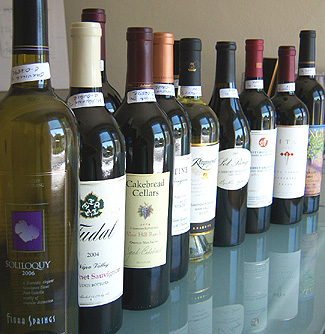
Look Closely...
There's a Quiet Evolution Happening in the Napa Valley
APPELLATION AMERICA's Best-of-Appellation Regional Evaluation Program recently focused its attention on some of the wines of the Napa Valley benchlands. The pleasant result was a bounty of Gold and Silver awards to a wide array of varietals, notably finding a new center of gravity around the issues of extraction and alcohol.
by Alan Goldfarb
May 27, 2008
 ust when you think you’ve nailed the profile of Napa Valley wines, the winemakers and producers in the nation’s leading wine region go back to the drawing board and demonstrate that you stay on top by taking the pulse and being creative.
ust when you think you’ve nailed the profile of Napa Valley wines, the winemakers and producers in the nation’s leading wine region go back to the drawing board and demonstrate that you stay on top by taking the pulse and being creative.
Perhaps the long term lesson that Robert Mondavi bestowed upon the vintners of the Napa Valley was for them to make the wines they would, personally, like to take home to dinner.
In the last few years, some Napa Valley wines in some circles have been ripped for their high alcohol and perceived unbalance. So, it seems, the message has
Toward that end, there’s a quiet evolution taking place in the Napa Valley. Some producers have taken up the cudgel of terroir-driven wines and are making 100 percent Cabernets again, as their forebears did in the evolutionary boom of the 1970s. This time, however, the Cabs are coming out of the estates in which they’re grown or from one of the 14 sub-appellations that comprise the valley itself.
One of those winemakers is Jeff McBride, the winemaker for Conn Creek in Rutherford, who set out six years ago to make Cab – vinted with the same protocols – from each of the AVAs of the valley.
Three vintages into the ambitious project, McBride’s 2004 Cabernet from St. Helena was one of three such wines to be awarded a gold medal recently for its appellation distinctiveness, evaluated
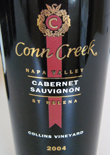 by APPELLATION AMERICA’s senior editors as the Web-based magazine embarks on its Best-of-Appellation Program (BOA).
by APPELLATION AMERICA’s senior editors as the Web-based magazine embarks on its Best-of-Appellation Program (BOA).
The wine, from the north-central valley-floor vineyard of Bill Collins, who founded Conn Creek Winery, displays mineral and chalky aromas from the parcel’s sedimentary and gravelly clay loam. The fruit is delicious and bright with dusty tannins for aging up to 10 years. It’s emblematic of the old vineyard and of wines that are coming out of the St. Helena AVA.
The wine, as do all of Conn Creek’s appellation-series offerings (see “Understanding the Napa Valley - one AVA at a time: An Interview with Jeff McBride”, AppellationAmerica, Oct. 5, 2006) sells for $45.
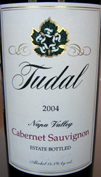 Other top award winners from APPELLATION AMERICA’s Napa Valley BOA evaluation tasting, which also showed their sense-of-place Cabernet footprint were the 2004 Tudal Estate Cabernet, also from St. Helena, and the Venge Vineyards 2004 Cabernet Sauvignon Reserve from Oakville.
Other top award winners from APPELLATION AMERICA’s Napa Valley BOA evaluation tasting, which also showed their sense-of-place Cabernet footprint were the 2004 Tudal Estate Cabernet, also from St. Helena, and the Venge Vineyards 2004 Cabernet Sauvignon Reserve from Oakville.
The Tudal ($35), from its 10-acre vineyard near the Napa River and - perhaps not coincidentally - just about a 100 yards due east of the Collins Vineyard, exhibits mushroom and black fruit aromas with dark, deep complex flavors – as well as those aforementioned tannins for long-term aging.
 The Venge 100 percent Cab from Oakville ($125) is from Saddleback Cellars estate vineyard, which was made famous by winemaker Kirk Venge’s father Nils. The vineyard, just east of Opus One and west of Groth, is dry-farmed. There are black cherry and mint-y aromas (the latter is a characteristic of Oakville Cabs), and the Venge has fabulous, concentrated fruit and power for long-term aging. It’s beautifully balanced and finishes with a listed alcohol percentage of 13.8.
The Venge 100 percent Cab from Oakville ($125) is from Saddleback Cellars estate vineyard, which was made famous by winemaker Kirk Venge’s father Nils. The vineyard, just east of Opus One and west of Groth, is dry-farmed. There are black cherry and mint-y aromas (the latter is a characteristic of Oakville Cabs), and the Venge has fabulous, concentrated fruit and power for long-term aging. It’s beautifully balanced and finishes with a listed alcohol percentage of 13.8. Two Sauvignon Blancs were also advanced to the Best-of-Appellation list in this round of BOA tastings. They are Flora Spring’s 2006 Soliloquy, and Raymond’s 2007 Reserve. Both wines are a wonderful representation of the type of Sauvignon Blancs the Napa Valley can produce.
This varietal - often overlooked in the region - falls somewhere between the Sauvignon Blancs from New Zealand
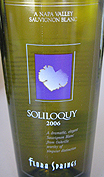 and those from the Loire Valley. With oak levels way down, the Napa Valley fruit, with decidedly Sauvignon Blanc typicity, is consistently full, bright and delicious, which occurs only occasionally down under and in Sancerre.
and those from the Loire Valley. With oak levels way down, the Napa Valley fruit, with decidedly Sauvignon Blanc typicity, is consistently full, bright and delicious, which occurs only occasionally down under and in Sancerre. The Flora Springs ($25), from the winery’s Crossroads Vineyard in Oakville, has lovely perfumed and grassy aromas, is delicious and concentrated and is in perfect balance. The vineyard is hot but Conn Creek (not the winery) to the east has a cooling effect, thus the goodly wash of acidity. Seventy percent of the grapes are augmented with the Sauvignon Musque clone, which gives the wine its body. Additionally, the wine was aged in neutral, 45-year-old eastern European barrels and did not go through malolactic fermentation.
 The Raymond ($15) was determined by one of APPELLATION AMERICA’s senior editors to be the “most varietally pure” of the flight. There are decided grassy aromas with a lean acid structure and grapefruit flavors, balance, and length.
The Raymond ($15) was determined by one of APPELLATION AMERICA’s senior editors to be the “most varietally pure” of the flight. There are decided grassy aromas with a lean acid structure and grapefruit flavors, balance, and length.
The fruit - 95% Sauvignon Blanc, 5% Semillon - comes from various vineyards in the eastern portion of the Napa Valley, where it’s slightly warmer than the valley floor. Some of the Sauvignon was also sourced from south of Yountville. The wine was fermented totally in stainless steel. The stated alcohol is 13.8 percent.
One of the more interesting wines of the day was the 2006 Frog’s Leap Zinfandel, which also received a Gold Medal and was advanced to the Best-of-Appellation list. APPELLATION AMERICA’s senior
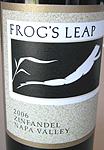 editors called this wine, “Back to the Future”. That’s because this is a Zin like they used to make in the past. But it is more emblematic of a Napa Valley Zinfandel than Zins from other California regions in that it’s not high in alcohol (a stated 13.5%), and that it’s made more in the claret style and more like a Bordeaux.
editors called this wine, “Back to the Future”. That’s because this is a Zin like they used to make in the past. But it is more emblematic of a Napa Valley Zinfandel than Zins from other California regions in that it’s not high in alcohol (a stated 13.5%), and that it’s made more in the claret style and more like a Bordeaux. This Frog’s Leap ($27) makes one remember what a Zinfandel used to taste like, in that it has gorgeous brambly aromas with good, tame structure, and is in perfect harmony.
Perhaps that’s because the wine was made by Frog’s Leap’s Zen-like winemaker John Williams, who got these grapes from his organic and biodynamically farmed vineyard. The
 READER FEEDBACK: To post your comments on this story,
click here
READER FEEDBACK: To post your comments on this story,
click here
Print this article | Email this article | More about Napa Valley | More from Alan Goldfarb










